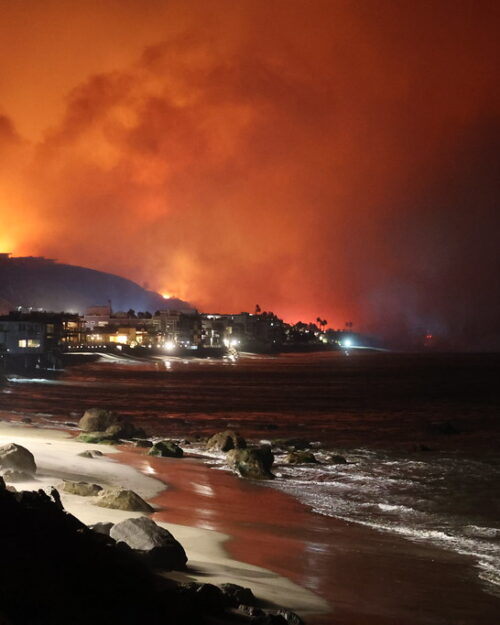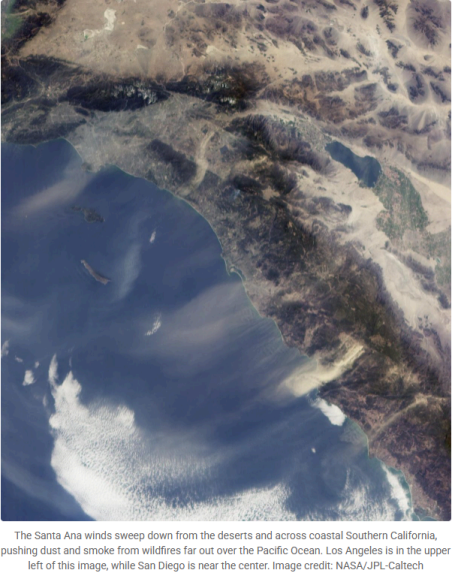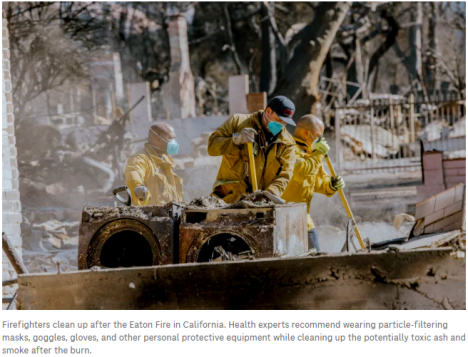August 14, 2025

By: AEOP Membership Council Gordon Chen
If you ask me, I’d say my favorite city is Los Angeles! I love visiting its beautiful beaches, renowned museums, colleges, and the Hollywood area. Every year, my family goes to the beach at Pacific Palisades. I lie on the soft sand, soaking in the warm sun, and smelling the fresh ocean air. After hiking in the Santa Monica Mountains, we enjoy pasta at our favorite restaurant nearby. When the sun goes down, the stars shine brightly, and we head to Griffith Observatory to look through telescopes. The next day, we walk through the UCLA and Caltech campuses and tour the Jet Propulsion Laboratory (JPL).
On the morning of January 7, 2025, wildfires broke out in Los Angeles. The flames spread quickly, reaching Palisades, Eaton, Hughes, and other areas. Cal Fire, the state’s fire agency, reported that the fires had burned approximately 50,536 acres in the Los Angeles area. Thousands of people lost their homes. Many of the Santa Monica Mountains and the National Recreation Area were burned. The iconic Griffith Observatory and JPL had to close temporarily.
Fortunately, the Los Angeles wildfires began to subside as rain helped to extinguish the flames. From January 7 to 31, 2025, eight destructive wildfires raged across Los Angeles.
These wildfires pose serious health risks. The smoke and ash contain harmful chemicals, metals, and plastics. Prolonged exposure to toxic gases can cause short-term effects like itchy eyes, trouble breathing, and skin rashes, as well as long-term issues such as heart disease, lung problems, and even cancer. Wind can spread smoke and harmful gases to areas far from the fire zones. Health experts recommend using particle-filtering masks and air purifiers indoors.
 The Santa Ana winds fan the Los Angeles wildfires, making them hard to control. They rapidly spread flames across the dry land. Other causes include climate change, which leads to drier conditions, rising temperatures, reduced rainfall, and longer fire seasons. According to expert insights from the Penn State Institute of Energy and the Environment on California wildfires, “Extended periods of drought further exacerbate the issue. Dry vegetation becomes ready to ignite with the slightest spark. These changes have contributed to an annual average burned area in 2020-2023 that is three times higher than in the 2010s.” Population growth has increased the risk of human-caused fires and placed more homes and lives in danger.
The Santa Ana winds fan the Los Angeles wildfires, making them hard to control. They rapidly spread flames across the dry land. Other causes include climate change, which leads to drier conditions, rising temperatures, reduced rainfall, and longer fire seasons. According to expert insights from the Penn State Institute of Energy and the Environment on California wildfires, “Extended periods of drought further exacerbate the issue. Dry vegetation becomes ready to ignite with the slightest spark. These changes have contributed to an annual average burned area in 2020-2023 that is three times higher than in the 2010s.” Population growth has increased the risk of human-caused fires and placed more homes and lives in danger.
California often experiences wildfires due to climate change, drought, and dry vegetation. I remember a wildfire near my home in 2020 when the wind swiftly spread flames from a dry hill. The sky turned gray with heavy smoke, and the air was thick with the acrid smell of fire. As schools shut down, I anxiously checked the live fire map, hoping the flames would stay away from my home. The firefighters contained the fire within two days. Our community worked together to clear the debris and repair the damage. Gradually, life returned to normal. It was the first time I truly saw how dangerous wildfires can be.
Early detection using advanced technologies and strategies can help mitigate the impact of wildfires. NASA’s Moderate Resolution Imaging Spectroradiometer (MODIS) and Visible Infrared Imaging Radiometer Suite (VIIRS) provide real-time fire data. Drones and ground-based radars use thermal imaging for rapid detection and response efforts. Forest-based camera networks continuously monitor forest areas, alerting authorities to smoke or unusual heat patterns.


Robotics assist in fire management by controlling burns, creating firebreaks, and reducing wildfire risks through precise vegetation management. Computational models simulate fire spread, predict risks, and help plan defenses. They also provide real-time forecasts and analyze past wildfire events to improve future wildfire response.
As part of an environmental research team, I study how satellite data helps in preventing wildfires. We use real-time satellite imagery to monitor fire-prone areas, analyze data with models, and predict fire behavior.
Small actions can help prevent fires. We have many ponds around our community. They are natural firebreaks, keeping the surrounding land moist. We carefully plant native, fire-resistant species such as oak trees, manzanita, and California lilac. Succulents like aloe vera, agave, and ice plants are also useful because they have high moisture content and low flammability. These plants help slow down fires and bring back the natural environment, giving animals a place to live. We clean up trash, trim overgrown plants, and remove dry grass and leaves on a weekly basis.
The Los Angeles wildfires remind us to care for nature and our communities. We need strong fire safety rules, reforestation, and better land management. Everyone can help prevent fires. Together, we can protect our land and keep our communities safe from wildfires.
Sources:
https://www.fire.ca.gov/incidents/2025
https://iee.psu.edu/news/blog/californias-wildfire-crisis-expert-insights-causes-spread-and-soluti ons#:~:text=Extended%20periods%20of%20drought%20further,higher%20than%20in%20the% 202010s
https://www.psu.edu/news/research/story/qa-causes-spread-and-solutions-californias-wildfire-cri sis
https://oehha.ca.gov/climate-change/epic-2022/impacts-vegetation-and-wildlife/wildfires
https://www.nbclosangeles.com/news/california-wildfires/la-fires-eaton-palisades-red-flag-warnin g/3609729/
https://www.npr.org/2025/01/19/nx-s1-5259900/la-wildfires-health-risks
https://ysph.yale.edu/news-article/when-climate-and-health-collide/#:~:text=As%20California%2 0authorities%20search%20for,that%20led%20to%20the%20catastrophe
https://www.un-spider.org/news-and-events/news/detecting-forest-fires-satellites-modis-and-viirs
https://climate-change.ieee.org/news/preventing-wildfires/
Find a Volunteering Opportunity
Visit our Program Volunteers page for a tool to find the best opportunity for you.
